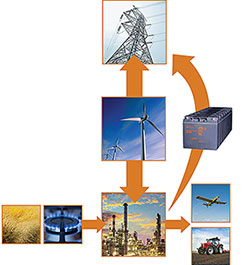The Value of Catalysis
By Bob Weber

Catalysts accelerate the rates of chemical reactions without being consumed in the reaction. They permit the use of less intense reaction conditions, smaller and typically cheaper reactors, and a higher selectivity towards the desired products. Selectivity enhances the utilization of feedstocks and lessens the scale and complexity of downstream separations. The resulting combination of smaller capital costs and smaller operating costs makes the use of catalysts ubiquitous in the production of fuels, chemicals, materials such as polymers, and in pollution abatement (for example, the catalytic converters that treat tailpipe emissions on all modern vehicles and power plants).
Research on catalysis offers at least three different kinds of value: economic, societal, and intellectual. The first stems from the creation of and continuous improvement in whole industries that are critical to the functioning of the world's economy (see table).
| Industry | 2013 Global Sales/(G$ year-1) |
| Ammonia | 4 |
| Petrochemicals | 400 |
| Petroleum refining | 600 |
The economic value of catalysis might be figured merely as the $16 billion/year in catalyst sales to those industries1. Alternately, the value proposition for sponsoring further corporate research on catalysis derives from its leverage on those industries $1 trillion/$16 billion = 60. Most recently, enzymes, which are biological catalysts, have enabled the founding of a nascent biofuels industry based on cellulosic feedstocks that avoid infringing on the food supply.
The societal value stream of catalysis is less easy to quantify but, nonetheless, essential to the well being of people and the environment. The U.S. Environmental Protection Agency2 estimated that the first 20 years of the U.S. Clean Air Act led to the prevention of
- 205,000 premature deaths
- 672,000 cases of chronic bronchitis
- 21,000 cases of heart disease
- 843,000 asthma attacks
- 189,000 cardiovascular hospitalizations
- 18 million child respiratory illnesses
In the same report, the agency further projected that the 1990 amendments to the Clean Air Act will prevent more than 160,000 premature deaths and generate an economic value of almost $2 trillion by 2020. Catalysis is critical to those gains because of its dual role. First, the emission control devices are catalytic reactors. Second, the processes employed to manufacture advanced clean fuels all employ catalysts. Additional, societal benefits can be attributed to the catalysts employed in the manufacture of pharmaceuticals.
Finally, the intellectual value of catalysis can be inferred from the significant number of Nobel Prizes–14% of the prizes and 19% of the prizewinners–that have been awarded for research on topics closely related to catalysis.
Dr. Robert (Bob) Weber leads research activities in heterogeneous catalysis for the Institute for Integrated Catalysis at Pacific Northwest National Laboratory. He is Theme Manager for the Spring 2015 ACS National Meeting (Denver) 2014-2015.
1Our estimates are based on U.S. Census statistics and annual financial reports of major catalyst companies and the companies involved in the listed industries
2http://www.epa.gov/air/caa/40th_highlights.html
3Ann M. Thayer, Chem. Engr. News, 2013, 91, 68

